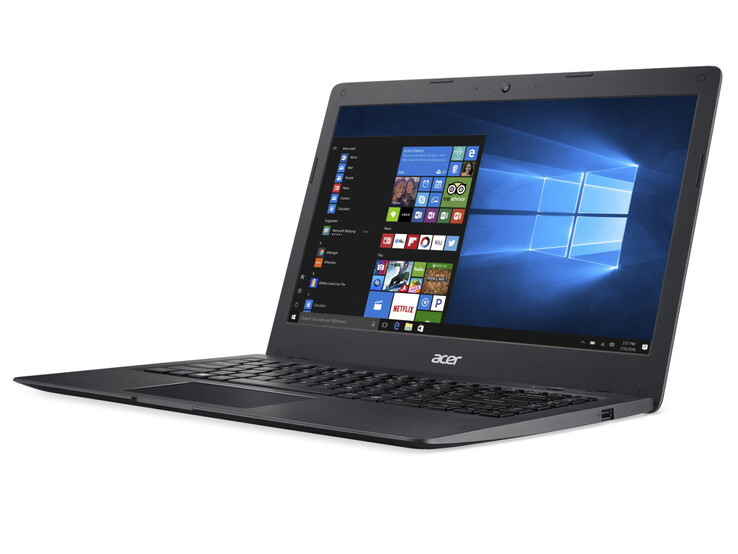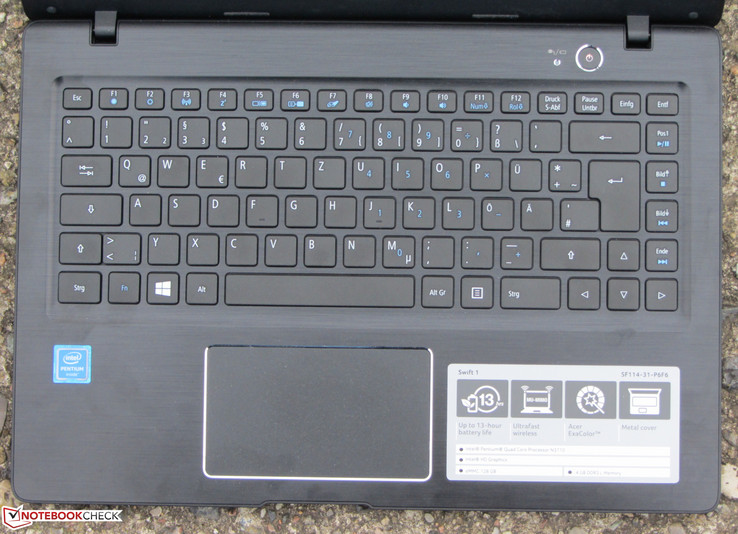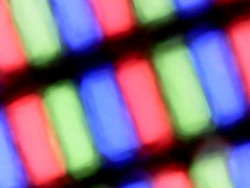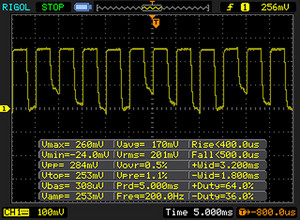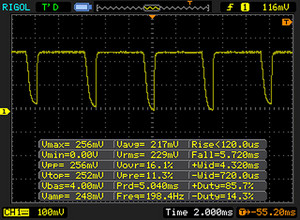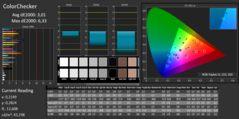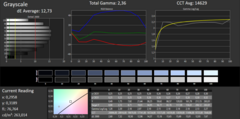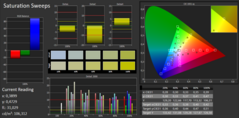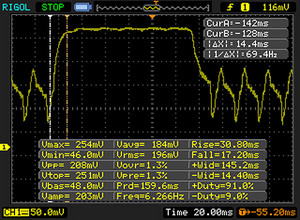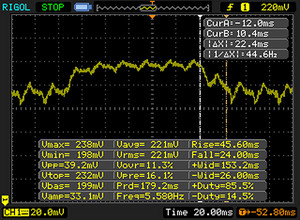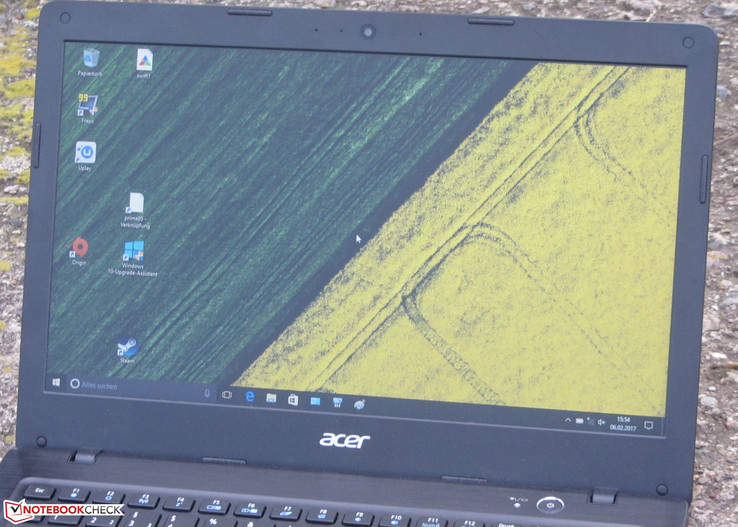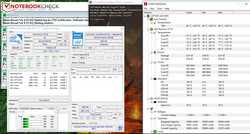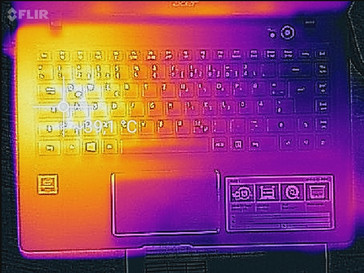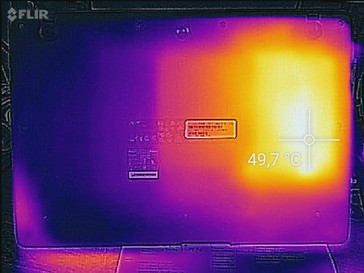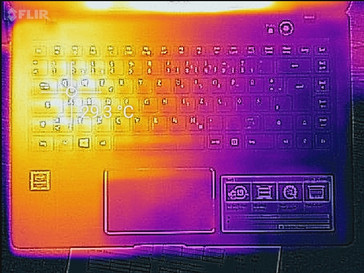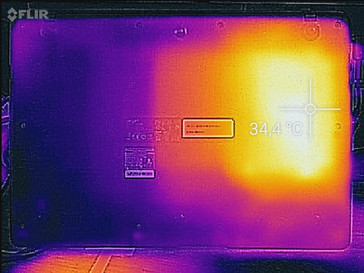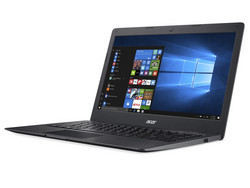Acer Swift 1 SF114-31-P6F6 Notebook Review

For the original German review, see here.
The Swift 1 is the entry-level model in Acer's Swift lineup. Core i and Core m processors are absent here. Acer relies on Braswell CPUs. The company kills two birds with one stone with this device: Firstly, the Swift is an affordable, enduring laptop in the series, and secondly, it is a rival for the Chromebook without the restrictions involved. A permanent Internet connection is not needed and there are no desktop applications. Laptops, such as Medion's Akoya S4219, Lenovo's E31-70, HP's Stream 13 and HP's Chromebook 14 are among its rivals.
Case and Connectivity
The casing of the Swift 1 is made mainly of plastic. Only the base unit's upper side is made of aluminum. Despite the use of plastic, the device can be described as stylish. As to its build, the laptop does not show any major shortcomings. This is slightly different as far as the robustness is concerned. In our opinion, the base unit can be warped a bit too easily. This is true to an even greater extent of the lid.
Acer has equipped the Swift 1 with the most necessary interfaces. One of the two Type-A USB ports supports the USB 3.0 standard. Acer should have installed a further Type-C port. The interface distribution is good: They are in the rear on both sides. The installed Wi-Fi module is a Wi-Fi chip (QCA9377) from Qualcomm. It supports the 802.11a/b/g/n Wi-Fi standards as well as the faster ac standard. However, the transmission rates are very poor, even under ideal conditions (no other Wi-Fi devices in the vicinity, short distance between the laptop and the server PC).
The installed memory card reader is not the fastest of its kind. A maximum transfer rate of 34.5 MB/s is achieved when copying large data blocks. Transferring 250 JPG image files (approx. 5 MB each) is performed at 20.6 MB/s. We test the memory card reader with a Toshiba Exceria Pro SDXC 64 GB UHS-II reference card. Unfortunately, SD cards cannot be inserted completely into the reader; they protrude by about 5 mm (~0.2 in).
Connectivity
| SD Card Reader | |
| average JPG Copy Test (av. of 3 runs) | |
| Medion Akoya S4219 | |
| HP Stream 13-c102ng | |
| Acer Swift 1 SF114-31-P6F6 | |
| Acer Aspire One Cloudbook 14 AO1-431-C6QM | |
| Lenovo E31-70 80KX015RGE | |
| maximum AS SSD Seq Read Test (1GB) | |
| Medion Akoya S4219 | |
| Acer Swift 1 SF114-31-P6F6 | |
| Lenovo E31-70 80KX015RGE | |
| HP Stream 13-c102ng | |
| Networking | |
| iperf3 transmit AX12 | |
| Lenovo IdeaPad 710S Plus-13IKB | |
| Acer Swift 1 SF114-31-P6F6 (jseb) | |
| iperf3 receive AX12 | |
| Lenovo IdeaPad 710S Plus-13IKB | |
| Acer Swift 1 SF114-31-P6F6 (jseb) | |
Input Devices
The Swift 1 comes with an unlit chiclet keyboard. The flat, lightly roughened keys have a short drop and clear pressure point. The keyboard yields slightly when typing on it. However, we did not find this annoying. Overall, Acer has installed a very decent keyboard that is designed for even prolonged typing sessions. The multitouch ClickPad has a surface area of approximately 10.6 x 6.1 cm (~4.2 x 2.4 in). Thus, it provides enough room for using gestures. The pad's sleek surface makes it easy for the fingers to glide over it. The pad has a short drop and defined pressure point.
Display
The matte 14-inch screen in the Swift has a native resolution of 1366x768 pixels. Neither its brightness (247.2 cd/m²) nor its contrast (474:1) convinces. However, the rates are acceptable in view of the laptop's price. Unfortunately, the screen exhibits PWM flickering at a frequency of 200 Hz in brightness levels of 90% and lower. This can lead to headaches and/or eye problems in sensitive users. To make things worse, the screen flickers permanently without the power supply, i.e. even at a brightness of 100%. The second screenshot under PWM (pulse-width modulation) illustrates this.
| |||||||||||||||||||||||||
Brightness Distribution: 80 %
Center on Battery: 270 cd/m²
Contrast: 474:1 (Black: 0.57 cd/m²)
ΔE ColorChecker Calman: 3.01 | ∀{0.5-29.43 Ø4.78}
ΔE Greyscale Calman: 12.73 | ∀{0.09-98 Ø5}
62% sRGB (Argyll 1.6.3 3D)
39% AdobeRGB 1998 (Argyll 1.6.3 3D)
42.35% AdobeRGB 1998 (Argyll 3D)
61.5% sRGB (Argyll 3D)
40.97% Display P3 (Argyll 3D)
Gamma: 2.36
CCT: 14629 K
| Acer Swift 1 SF114-31-P6F6 TN LED, 1366x768, 14" | Acer Aspire One Cloudbook 14 AO1-431-C6QM TN LED, 1366x768, 14" | Medion Akoya S4219 IPS, 1920x1080, 14" | Lenovo E31-70 80KX015RGE TN, 1366x768, 13.3" | HP Stream 13-c102ng TN, 1366x768, 13.3" | HP Chromebook 14 G1 TN, 1366x768, 14" | |
|---|---|---|---|---|---|---|
| Display | -1% | 45% | 20% | -1% | ||
| Display P3 Coverage (%) | 40.97 | 40.68 -1% | 61.7 51% | 49.25 20% | 40.68 -1% | |
| sRGB Coverage (%) | 61.5 | 60.6 -1% | 84.8 38% | 73.5 20% | 59.8 -3% | |
| AdobeRGB 1998 Coverage (%) | 42.35 | 42.08 -1% | 62 46% | 50.9 20% | 42.32 0% | |
| Response Times | -14% | 20% | -4% | -12% | ||
| Response Time Grey 50% / Grey 80% * (ms) | 32 ? | 49.6 ? -55% | 33 ? -3% | 44.4 ? -39% | 45 ? -41% | |
| Response Time Black / White * (ms) | 30 ? | 21.6 ? 28% | 17 ? 43% | 20.4 ? 32% | 25 ? 17% | |
| PWM Frequency (Hz) | 200 ? | 200 ? | 50 ? | 200 ? | 201 ? | |
| Screen | -31% | 28% | -36% | -22% | 7% | |
| Brightness middle (cd/m²) | 270 | 231 -14% | 216 -20% | 206 -24% | 190 -30% | 226 -16% |
| Brightness (cd/m²) | 247 | 213 -14% | 211 -15% | 200 -19% | 179 -28% | 227 -8% |
| Brightness Distribution (%) | 80 | 87 9% | 65 -19% | 84 5% | 85 6% | 86 8% |
| Black Level * (cd/m²) | 0.57 | 0.47 18% | 0.2 65% | 0.6 -5% | 0.33 42% | 0.4 30% |
| Contrast (:1) | 474 | 491 4% | 1080 128% | 343 -28% | 576 22% | 565 19% |
| Colorchecker dE 2000 * | 3.01 | 9.1 -202% | 3.7 -23% | 9.2 -206% | 9.84 -227% | |
| Colorchecker dE 2000 max. * | 6.33 | 14.88 -135% | 5.88 7% | 14.8 -134% | ||
| Greyscale dE 2000 * | 12.73 | 9.55 25% | 2.67 79% | 10.94 14% | 10.32 19% | |
| Gamma | 2.36 93% | 2.47 89% | 2.65 83% | 2.76 80% | 2.48 89% | |
| CCT | 14629 44% | 11384 57% | 6418 101% | 13282 49% | 11884 55% | |
| Color Space (Percent of AdobeRGB 1998) (%) | 39 | 38.84 0% | 55 41% | 46.92 20% | 38 -3% | |
| Color Space (Percent of sRGB) (%) | 62 | 60.59 -2% | 85 37% | 73.36 18% | 60 -3% | |
| Total Average (Program / Settings) | -15% /
-23% | 31% /
30% | -7% /
-20% | -12% /
-16% | 7% /
7% |
* ... smaller is better
Screen Flickering / PWM (Pulse-Width Modulation)
| Screen flickering / PWM detected | 200 Hz | ≤ 90 % brightness setting | |
The display backlight flickers at 200 Hz (worst case, e.g., utilizing PWM) Flickering detected at a brightness setting of 90 % and below. There should be no flickering or PWM above this brightness setting. The frequency of 200 Hz is relatively low, so sensitive users will likely notice flickering and experience eyestrain at the stated brightness setting and below. In comparison: 53 % of all tested devices do not use PWM to dim the display. If PWM was detected, an average of 8108 (minimum: 5 - maximum: 343500) Hz was measured. | |||
Display Response Times
| ↔ Response Time Black to White | ||
|---|---|---|
| 30 ms ... rise ↗ and fall ↘ combined | ↗ 16 ms rise | |
| ↘ 14 ms fall | ||
| The screen shows slow response rates in our tests and will be unsatisfactory for gamers. In comparison, all tested devices range from 0.1 (minimum) to 240 (maximum) ms. » 79 % of all devices are better. This means that the measured response time is worse than the average of all tested devices (20.2 ms). | ||
| ↔ Response Time 50% Grey to 80% Grey | ||
| 32 ms ... rise ↗ and fall ↘ combined | ↗ 10 ms rise | |
| ↘ 22 ms fall | ||
| The screen shows slow response rates in our tests and will be unsatisfactory for gamers. In comparison, all tested devices range from 0.165 (minimum) to 636 (maximum) ms. » 42 % of all devices are better. This means that the measured response time is similar to the average of all tested devices (31.6 ms). | ||
Performance
With its Swift 1, Acer has a 14-inch laptop that is suitable for using basic office and Internet applications. The integrated video decoder also allows playing videos - at home or on the go. Our review sample is priced at approximately 400 Euros (~$422). Only one other model (Celeron N3060, 64 GB eMMC) was available for 300 Euros (~$317) at the time of testing.
Processor
The Swift is powered by Intel's Pentium N3710 (Braswell) quad-core processor. The CPU's computing power is enough for simple office and Internet applications. The SoC's low TDP allows passive cooling, which is also implemented here. The CPU clocks at a base speed of 1.6 GHz, which can be boosted to 2.56 GHz via Turbo. Our CPU tests were performed at full speed. It is too bad that Acer relies on the Braswell platform and not on the new Apollo Lake platform. The CPU and GPU performance of the latter has been increased considerably compared with Braswell.
| Cinebench R15 | |
| CPU Single 64Bit | |
| Lenovo E31-70 80KX015RGE | |
| Acer Aspire ES1-332-P91H | |
| Acer Swift 1 SF114-31-P6F6 | |
| Medion Akoya S4219 | |
| Acer Aspire One Cloudbook 14 AO1-431-C6QM | |
| HP Stream 13-c102ng | |
| CPU Multi 64Bit | |
| Lenovo E31-70 80KX015RGE | |
| Acer Aspire ES1-332-P91H | |
| Acer Swift 1 SF114-31-P6F6 | |
| Medion Akoya S4219 | |
| Acer Aspire One Cloudbook 14 AO1-431-C6QM | |
| HP Stream 13-c102ng | |
| Cinebench R10 | |
| Rendering Multiple CPUs 32Bit | |
| Lenovo E31-70 80KX015RGE | |
| Acer Aspire ES1-332-P91H | |
| Acer Swift 1 SF114-31-P6F6 | |
| Medion Akoya S4219 | |
| Acer Aspire One Cloudbook 14 AO1-431-C6QM | |
| HP Stream 13-c102ng | |
| Rendering Single 32Bit | |
| Lenovo E31-70 80KX015RGE | |
| Acer Aspire ES1-332-P91H | |
| Acer Swift 1 SF114-31-P6F6 | |
| Medion Akoya S4219 | |
| Acer Aspire One Cloudbook 14 AO1-431-C6QM | |
| HP Stream 13-c102ng | |
| Geekbench 3 | |
| 32 Bit Single-Core Score | |
| Acer Aspire ES1-332-P91H | |
| Acer Swift 1 SF114-31-P6F6 | |
| Acer Aspire One Cloudbook 14 AO1-431-C6QM | |
| 32 Bit Multi-Core Score | |
| Acer Aspire ES1-332-P91H | |
| Acer Swift 1 SF114-31-P6F6 | |
| Acer Aspire One Cloudbook 14 AO1-431-C6QM | |
| Geekbench 4.0 | |
| 64 Bit Single-Core Score | |
| Acer Aspire ES1-332-P91H | |
| Acer Swift 1 SF114-31-P6F6 | |
| 64 Bit Multi-Core Score | |
| Acer Aspire ES1-332-P91H | |
| Acer Swift 1 SF114-31-P6F6 | |
| JetStream 1.1 - Total Score | |
| Lenovo E31-70 80KX015RGE | |
| Acer Aspire ES1-332-P91H | |
| Acer Swift 1 SF114-31-P6F6 | |
| Medion Akoya S4219 | |
| Acer Aspire One Cloudbook 14 AO1-431-C6QM | |
System Performance
The system makes a smoother impression during use than we are used to from other comparable devices. Acer seems to have matched the components well. The very decent PCMark 8 scores confirm this impression. It is not possible to increase the total performance. Positive: The soldered working memory operates in dual-channel mode.
| PCMark 8 Home Score Accelerated v2 | 2114 points | |
| PCMark 8 Creative Score Accelerated v2 | 2302 points | |
| PCMark 8 Work Score Accelerated v2 | 1595 points | |
Help | ||
| PCMark 8 - Home Score Accelerated v2 | |
| Lenovo E31-70 80KX015RGE | |
| Acer Swift 1 SF114-31-P6F6 | |
| Acer Aspire ES1-332-P91H | |
| Medion Akoya S4219 | |
| Acer Aspire One Cloudbook 14 AO1-431-C6QM | |
| HP Stream 13-c102ng | |
Storage Device
Data can be stored on an eMMC module with a total capacity of 128 GB. Almost 96 GB of this can be used. The storage device's transfer rates are on a normal level for eMMC modules. The storage capacity can be expanded via an SD card when required. However, this is rather a theoretical option. Since SD cards protrude out of the memory card reader by about 5 mm (~0.2 in) and the cards are not locked in place, this is not really practical.
| Acer Swift 1 SF114-31-P6F6 128 GB eMMC Flash | Acer Aspire One Cloudbook 14 AO1-431-C6QM 32 GB eMMC Flash | Medion Akoya S4219 128 GB eMMC Flash | Lenovo E31-70 80KX015RGE Seagate ST500LM000 Solid State Hybrid Drive | HP Stream 13-c102ng 32 GB eMMC Flash | |
|---|---|---|---|---|---|
| CrystalDiskMark 3.0 | -11% | -3% | -53% | 1% | |
| Read Seq (MB/s) | 166.5 | 173.5 4% | 151.2 -9% | 116.4 -30% | 152.8 -8% |
| Write Seq (MB/s) | 85 | 77.9 -8% | 55.7 -34% | 120.7 42% | 76.9 -10% |
| Read 512 (MB/s) | 153.8 | 154.8 1% | 156.6 2% | 37.01 -76% | 167 9% |
| Write 512 (MB/s) | 75.6 | 64.1 -15% | 46.9 -38% | 73.1 -3% | 22.79 -70% |
| Read 4k (MB/s) | 13.2 | 15.88 20% | 16.29 23% | 0.507 -96% | 18.28 38% |
| Write 4k (MB/s) | 13.04 | 8.583 -34% | 16.5 27% | 4.156 -68% | 16.78 29% |
| Read 4k QD32 (MB/s) | 35.12 | 25.73 -27% | 20.62 -41% | 0.967 -97% | 31.59 -10% |
| Write 4k QD32 (MB/s) | 12.66 | 8.656 -32% | 18.86 49% | 0.652 -95% | 16.08 27% |
Graphics Card
Intel's HD Graphics 405 GPU is installed. It supports DirectX 12 and clocks at speeds of up to 700 MHz. The 3DMark scores are on a normal level for the GPU installed here. The dual-channel working memory has a positive impact here. A look at our comparison chart reveals that the HD Graphics 505 successor is considerably stronger - on a low level.
| 3DMark 11 Performance | 565 points | |
Help | ||
| 3DMark 11 - 1280x720 Performance GPU | |
| Lenovo E31-70 80KX015RGE | |
| Acer Aspire ES1-332-P91H | |
| Acer Swift 1 SF114-31-P6F6 | |
| Medion Akoya S4219 | |
| Acer Aspire One Cloudbook 14 AO1-431-C6QM | |
| HP Stream 13-c102ng | |
Gaming Performance
The installed SoC can render only a few games smoothly. The older a game is, the more likely it is that it will run on the Swift. However, the user will have to be satisfied with low resolutions and low quality settings. Considerably more playable games are found in Casual Games in Windows Store.
| low | med. | high | ultra | |
|---|---|---|---|---|
| The Elder Scrolls V: Skyrim (2011) | 21.8 | 10.4 | 6.5 | |
| Dead Space 3 (2013) | 43.2 | 19.6 | 14.3 | |
| BioShock Infinite (2013) | 23.2 | 11.8 | 10 | |
| Battlefield 4 (2013) | 16.5 | 12.5 | 8.3 | |
| Risen 3: Titan Lords (2014) | 14 | 9.1 | ||
| Alien: Isolation (2014) | 18.9 | 13.6 | ||
| Dragon Age: Inquisition (2014) | 12.1 | 7.6 | ||
| Dota 2 Reborn (2015) | 35.2 | 22.8 | ||
| Anno 2205 (2015) | 10.8 | 6.9 | ||
| Rainbow Six Siege (2015) | 15.3 | 8.9 | ||
| Rise of the Tomb Raider (2016) | 7.1 | 4.2 | ||
| Mirror's Edge Catalyst (2016) | 10.5 | 6.1 | ||
| Civilization 6 (2016) | 12.2 | 5.2 | ||
| Farming Simulator 17 (2016) | 31.3 | 21.3 | ||
| Titanfall 2 (2016) | 14.4 | 10.5 | ||
| Resident Evil 7 (2017) | 13.5 | 11 |
Emissions and Energy Management
System Noise
The Swift is cooled passively. Thus, a fan that could produce noise is not installed. An occasional crackling from inside the laptop was audible during our gaming test. However, the laptop's speakers have to be turned off and the user has to be in a very quiet environment to hear this at all. This was not observed in routine office use.
Temperature
The Swift performed our stress test (Prime95 and FurMark run for at least one hour) similarly in AC and battery mode. The CPU and GPU clocked at high speeds for only a few seconds before the processor was throttled to 800 MHz and the graphics core to 480 MHz. These rates were maintained for 20 to 30 minutes. Then, the CPU and GPU gradually throttled a bit further to 720 MHz (CPU) and 460 MHz (GPU). The laptop's temperature development is within limits. 40 degrees Celsius (~104 degrees Fahrenheit) was exceeded on two measuring points during the stress test. The temperatures were much lower in routine use.
(+) The maximum temperature on the upper side is 36.6 °C / 98 F, compared to the average of 35.9 °C / 97 F, ranging from 21.4 to 59 °C for the class Subnotebook.
(±) The bottom heats up to a maximum of 44.2 °C / 112 F, compared to the average of 39.3 °C / 103 F
(+) In idle usage, the average temperature for the upper side is 25 °C / 77 F, compared to the device average of 30.8 °C / 87 F.
(+) The palmrests and touchpad are cooler than skin temperature with a maximum of 31.9 °C / 89.4 F and are therefore cool to the touch.
(-) The average temperature of the palmrest area of similar devices was 28.2 °C / 82.8 F (-3.7 °C / -6.6 F).
Speakers
The stereo speakers are situated on the device's underside. They produce a thin sound without much bass. Headphones or external speakers will have to be used for a better sound experience.
Acer Swift 1 SF114-31-P6F6 audio analysis
(±) | speaker loudness is average but good (75 dB)
Bass 100 - 315 Hz
(-) | nearly no bass - on average 22.8% lower than median
(+) | bass is linear (2.4% delta to prev. frequency)
Mids 400 - 2000 Hz
(±) | reduced mids - on average 9.4% lower than median
(±) | linearity of mids is average (7.4% delta to prev. frequency)
Highs 2 - 16 kHz
(+) | balanced highs - only 2.6% away from median
(+) | highs are linear (2.7% delta to prev. frequency)
Overall 100 - 16.000 Hz
(±) | linearity of overall sound is average (22.2% difference to median)
Compared to same class
» 75% of all tested devices in this class were better, 5% similar, 20% worse
» The best had a delta of 5%, average was 18%, worst was 53%
Compared to all devices tested
» 64% of all tested devices were better, 6% similar, 30% worse
» The best had a delta of 4%, average was 24%, worst was 134%
Apple MacBook 12 (Early 2016) 1.1 GHz audio analysis
(+) | speakers can play relatively loud (83.6 dB)
Bass 100 - 315 Hz
(±) | reduced bass - on average 11.3% lower than median
(±) | linearity of bass is average (14.2% delta to prev. frequency)
Mids 400 - 2000 Hz
(+) | balanced mids - only 2.4% away from median
(+) | mids are linear (5.5% delta to prev. frequency)
Highs 2 - 16 kHz
(+) | balanced highs - only 2% away from median
(+) | highs are linear (4.5% delta to prev. frequency)
Overall 100 - 16.000 Hz
(+) | overall sound is linear (10.2% difference to median)
Compared to same class
» 7% of all tested devices in this class were better, 2% similar, 91% worse
» The best had a delta of 5%, average was 18%, worst was 53%
Compared to all devices tested
» 4% of all tested devices were better, 1% similar, 94% worse
» The best had a delta of 4%, average was 24%, worst was 134%
Frequency diagram in comparison (checkboxes above can be turned on/off!)
Power Consumption
The Swift's power consumption is inconspicuous. The energy requirement is on a normal level for the installed hardware platform over the entire load range.
| Off / Standby | |
| Idle | |
| Load |
|
Key:
min: | |
Battery Runtime
A sticker on the Swift promises a battery life of up to 13 hours. This time proved to be quite realistic in practice. Acer's laptop achieved a runtime of 11:01 hours in our practical Wi-Fi test - a very good outcome. Here, we simulate the load needed for opening websites. The "Balanced" profile is enabled, the energy-savings mode is disabled, and the screen's brightness is set to approximately 150 cd/m².
| Battery Runtime - WiFi Websurfing | |
| Acer Swift 1 SF114-31-P6F6 | |
| Acer Aspire One Cloudbook 14 AO1-431-C6QM | |
| HP Chromebook 14 G1 | |
| HP Stream 13-c102ng | |
| Medion Akoya S4219 | |
| Lenovo E31-70 80KX015RGE | |
Pros
Cons
Verdict
The Swift 1 is the lowest-performance and cheapest model in Acer's Swift lineup. However, it does not need to hide. Although the casing is mainly made of plastic, the Swift 1 can be described as stylish. This is also due to its slim exterior. The Swift 1 cannot compete with the Core i and Core m processors in its more expensive siblings. The installed Pentium N3710 processor is suitable for basic office and Internet applications.
Acer has a stylish, slim and enduring typewriter and browsing machine in its portfolio. The price of just under 400 Euros (~$422) also makes the device affordable for pupils and students.
The laptop is always silent and does not heat up excessively. The storage device has a capacity of 128 GB. Almost 96 GB of this can be used. This should be enough for most users. The laptop does not feature a backlit keyboard. The installed unit makes a very decent impression and can be used for frequent typing. The superb battery life adds to that. The laptop's relatively low price is reflected in the screen. Acer has installed a dark, low-contrast, viewing angle dependent panel. Nevertheless: The screen is acceptable in view of the low price.
Finally, a wish list for a potential successor: Dear Acer, in addition to an Apollo Lake SoC, a backlit keyboard, and at least one Type-C USB port would be appreciated. An IPS screen would round things off, but this will probably remain a wish considering the Swift 1's price.
Acer Swift 1 SF114-31-P6F6
- 02/09/2017 v6 (old)
Sascha Mölck




